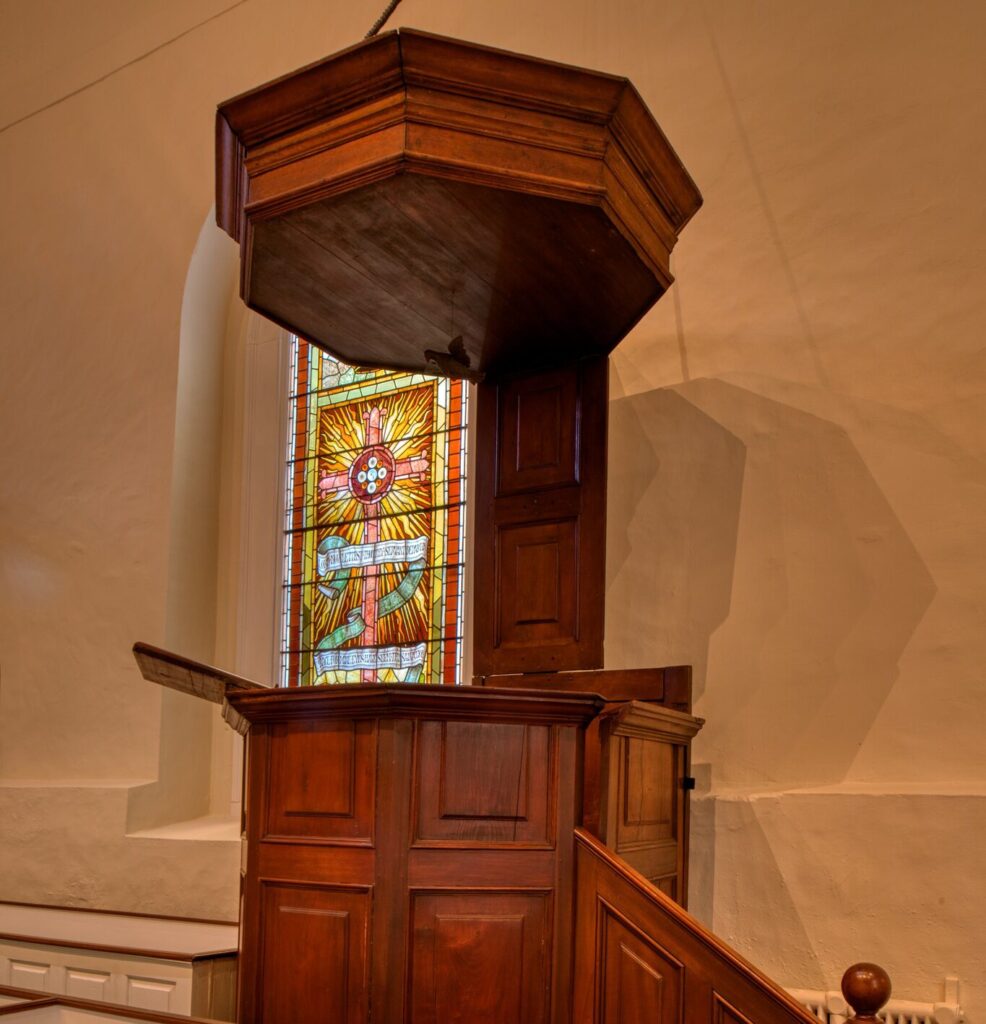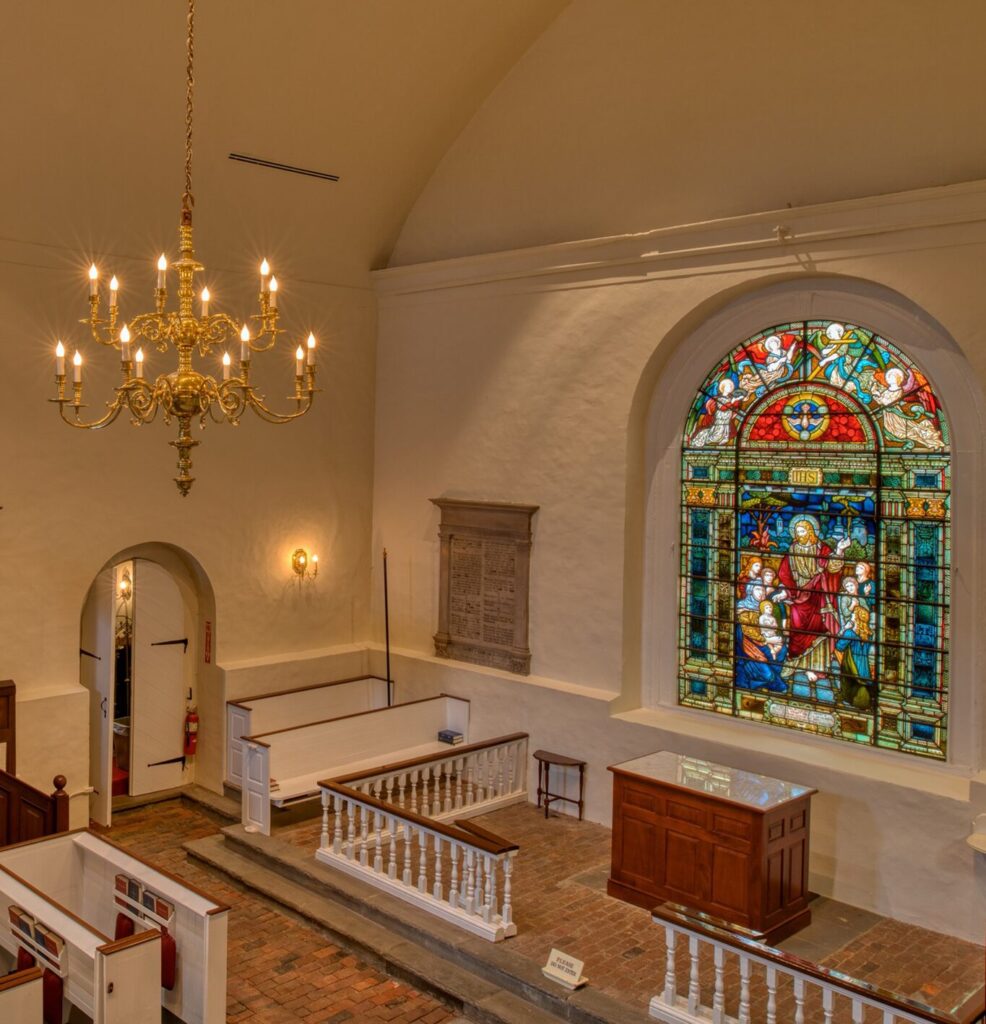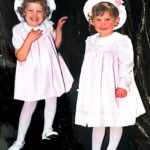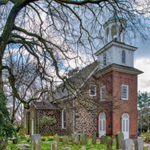Old Swedes:
325 Years of Faith and Service
Trinity Episcopal Parish in Wilmington is celebrating the 325th anniversary of the consecration of Old Swedes Church, a constituent of First State National Historical Park, with a series of events culminating in a visit by Presiding Bishop Michael Curry on July 28th. This article has been adapted from a parish historical overview written by Michael Redmond, a Delaware Communion Magazine contributing writer and a member of the Trinity Parish vestry. Special thanks to Betsy V. Christopher of the Old Swedes Foundation.



by Michael Redmond
The official seal of Trinity Episcopal Parish bears the emblem of a tree. It represents a verse from holy scripture: “(the righteous) are like trees planted by streams of water, which yield their fruit in its season, and their leaves do not wither. In all that they do, they prosper” (Ps. 1:3, NRSV). Those righteous were the hardy Swedes who founded the Colony of New Sweden in 1638; the tree was their church, Helga Trefaldighet Kyrka (Holy Trinity Church), and the “streams of water” was the river close by, which they had named for their queen, Christina. Their settlement was also named for the queen, too: Fort Christina. This was the foundation of the city that would eventually be known as Wilmington.
In time, the small community of colonists — adherents of the Church of Sweden (Lutheran) — outgrew the log cabin chapels in which they worshipped, and aspired to build a larger, stone-built edifice. The inspiration and the energy for this project largely came from a new arrival from Sweden, the Rev. Erik Björk (1668 – 1740), missionary priest, who disembarked in June 1697 and had the new church up, finished, and ready for consecration on Trinity Sunday, June 4, 1699. Joining him on that eventful day were two of the missionary colleagues with whom he made the voyage to North America, the Rev. Jonas Aureen and the Rev. Anders Rudman.
Fort Christina had long had a burial ground to its north, and it was felt that the new church location should incorporate the burial ground. Parishioner John Stalcop donated land to make this a reality, and he also agreed to sell about 500 acres to the congregation. Mr. Stalcop’s parcel to the church’s north (228 acres, equivalent to 173 football fields) includes today’s central Wilmington. The “Delaware Blue” granite used to build the church was quarried from the property of another parishioner, Ashmund Stidham. The church’s black walnut pulpit — one of the oldest known pulpits in the United States — was built with wood donated by the earliest parishioners.
From its beginning, the Colony of New Sweden was beset by difficulties. No more than two dozen people — Swedes, Finns, Dutch, and one African slave named Antonius (Antoni Swart, “Black Anthony”), a sailor — formed the original settlement, and although the colony grew in size and population, New Sweden always remained small compared to the Dutch or English colonies in North America.
The short-lived colony was diverse from the start. In addition to the Swedes, Finns, and Dutch, the early decades of white settlement included Belgians and Germans. The land had once been inhabited by the Native American Siconese Lenape, whose presence was much diminished by disease, famine, and warfare. Old Swedes records show that adults and children variously described as “Negro,” “mulatto,” “Free Negro,” “black people,” and “Indian” were baptized in the church as early as 1715. The records also show that persons described as “colored” were married there. It is assumed that people of color, both free and enslaved, were interred in the burial ground. No record has been found that burials were ever segregated, a common practice at the time.
The history of slavery in Delaware began with the Colony of New Sweden and despite attempts to ban it, continued until the ratification of the Thirteenth Amendment to the U.S. Constitution in December 1865. By 1810, however, according to the U.S. Census, three-quarters of all Black Delawareans were free.
It has been estimated that the Old Swedes burial ground — some three acres in extent — could be the final resting place of as many as 15,000 people. Among them are 44 Revolutionary War veterans; Richard Bayard (1796 – 1868), first mayor of Wilmington; three U.S. senators; a U.S. Army general who served during the Civil War; and the Rt. Rev. Alfred Lee (1807 – 1887), first bishop of the Episcopal Church in Delaware, later 10th presiding bishop of The Episcopal Church. Also noteworthy is Florence Bayard Hilles (1866 – 1954), an important figure in the national movement for women’s suffrage.
By the tenure of the sixth rector, the Rev. Peter Tranberg (1716 – 1748), Delaware had been British for nearly 80 years, and the Swedish language had “very much fallen out of use.” Due to his high proficiency in English, the Rev. Tranberg offered both English and Swedish services, attracting Wilmington’s growing Anglican community, who lacked a local church. Old Swedes’ records show that many early baptisms, weddings, and funerals were performed for families who were not members of the congregation.
Out of necessity, the crossing of denominational lines was not uncommon among Protestants in early America. There was ample precedent. The Rev. Björk had preached on occasion to Anglican congregations in New Castle and Chester, Pennyslvania. He wrote regarding this: “We have always been counseled and instructed from Sweden to maintain friendship and unity with the English, so that we and the English Church shall not reckon each other as dissenters … but as sister Churches.”
The Old Swedes congregation grew. By the 1770s the church required more seating. Renovations were made, and a gallery was built along the west wall. Then came the American Revolution. In 1777 services were discontinued while two companies of British and Hessian soldiers were quartered in the church.
By the end of the Revolutionary War and the establishment of the United States of America, the Swedes among the congregation had become fully assimilated into American culture, including the complete loss of “knowledge of the Swedish language.” In 1782 The Church of Sweden began withdrawing from its missionary work in the new American republic; the last Swedish pastor of Old Swedes, the Rev. Lars Girelius, was eventually recalled.
In October 1786 the third General Convention of the Protestant Episcopal Church of the United States was held in Wilmington; the convention’s worship took place in Old Swedes. The parish formally became Episcopal in 1791. Ever since, nonetheless, Holy Trinity Episcopal Parish has acknowledged the Swedish settlers as its founders and recognized 1699 as its foundation.
The 19th century bought sweeping growth and change, including the industrialization of the riverfront. The City of Wilmington was expanding westward. Having outgrown Old Swedes, the Trinity congregation built a new sanctuary uptown at Fifth and King streets. In 1847 regular worship was being conducted at both locations. In 1882 the parish moved again — farther uptown, to a small chapel it had built at North Adams Street and Delaware Avenue to serve the congregation while the construction of the present Trinity Church was completed. Designed by Philadelphia architect Theophilus P. Chandler Jr. in the English Gothic style, the new Holy Trinity Church was consecrated on May 15, 1906. Worship at Old Swedes continued as before — one parish, two congregations, two locations.
But the story of a parish is more than marble and mortar.
In 1948 the former vicarage at Old Swedes was renovated and expanded to form the Christiana Community Center, the site of a wide range of programs serving Wilmington’s East Side neighborhood. Among the offerings were sports, arts and crafts, club rooms, a library and reading room, a music room, and a recreation hall. Services included health clinics and vocational, educational, and employment counseling. Today’s Trinity Parish is keeping a close eye on plans to revitalize the East Side and is seeking to envision how the Old Swedes Historic Site might support that effort.
In 1947 the independent, not-for-profit Old Swedes Foundation was established to preserve and promote the Old Swedes Church and burial ground as an educational and cultural resource. In 1959 the stone Hendrickson House, a farmhouse built around 1622 and moved from a site in Delaware County, Pennsylvania, was reconstructed as a museum at the west side of the burial ground.
Later additions, created by Trinity Parish volunteers, include an outdoor amphitheater and a 42-foot labyrinth.
Old Swedes Church was designated a Registered National Historic Landmark in 1961. Old Swedes Church and Burial Ground was designated a unit of First State National Historical Park in 2015.
Noteworthy visitors to Old Swedes include President Franklin D. Roosevelt, in 1938; Lyndon B. Johnson, in 1963, then vice president of the United States; and Their Majesties King Carl XVI Gustaf and Queen Silvia of Sweden, during a state visit in 2013.
The Old Swedes neighborhood is changing. The City of Wilmington is changing. Trinity Episcopal Parish is dedicated to changing along with them. While rooted in tradition, Trinity Parish is eager to engage with the new.
Acknowledgments: * Betsy V. Christopher, Images of America: Old Swedes Church and Historic Site (Arcadia Publishing, 2023, ISBN 9781-4671-6044-5) * A Historic Saga of Settlement and Nation Building: First State National Historical Park: Historic Site Resource Study. Prepared by Paula S. Reed & Associates for the National Park Service, 2019. * Charles A. Silliman, The Episcopal Church in Delaware, 1785-1954 (Diocese of Delaware, 1982) * C.A. Weslager, New Sweden on the Delaware: 1638-1655 (The Middle Atlantic Press, 1988) * Angela Sutton, Ph.D., The Slave Trade and Its Legacy in the New World, Vanderbilt University, 2021.

A versatile editor and writer with an extensive background in daily journalism, Michael Redmond, is a regular contributor to the Delaware Communion Magazine and a member of the diocesan communications team. mr@michaelredmond.net





